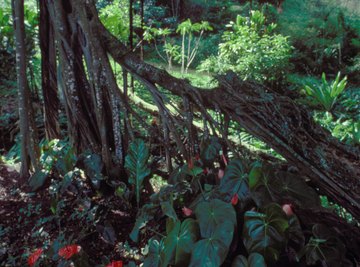
A biologically vibrant ecosystem elegantly demonstrates how a group of organisms can adapt to their environmental surroundings. No place on Earth provides a perfect environment free of environmental stresses and resource limitations; thus, ecological research seeks to understand the ways in which living organisms endure and thrive amid the nonliving characteristics -- both desirable and undesirable -- of their particular ecosystem. Two familiar examples of nonliving ecological components are the precipitation patterns in the American Great Plains and the chemical composition of an ordinary pond.
Adapting to the Environment
The aspects of an ecosystem can be grouped into two broad categories: biotic components and abiotic components. Biotic components include all living organisms, and are further classified according to their function: producers, such as:
- bacteria
- fungi
Abiotic components, also referred to as abiotic factors, include the various nonliving characteristics that influence the lives of the biotic components -- for example, what they eat, where they find water and how they survive harsh weather.
Abiotic Overview
Abiotic components cover a wide range of physical, chemical and climatic conditions. The dominant abiotic components in many ecosystems are weather patterns or are influenced by weather patterns -- organisms in natural environments must tolerate the weather every day of the year; most have little ability to create favorable microclimates for themselves. Examples include:
- ambient temperatures
- seasonal variations
- precipitation
- sunlight
- wind
- relative humidity
Soil characteristics -- such as texture, organic matter content and mineral composition -- are also critical abiotic factors in many terrestrial ecosystems. Abiotic factors such as the chemical composition and nutrient content of water play a similar role in aquatic ecosystems.
The Influence of Low Rainfall
The precipitation patterns of the American plains were important abiotic components of the native prairie ecosystems in those regions. The Great Plains, consisting of such areas as western Kansas and most of Nebraksa, have fairly low average rainfall, often less than 16 inches in a year. This low rainfall -- in conjunction with other abiotic characteristics such as uncommonly rich soil and windy winters -- led to interesting biotic characteristics. For example, trees had difficulty establishing themselves naturally during summers with long periods of drought. Consequently, trees grew primarily near bodies of water, and the rest of the land developed into a vast expanse of drought-tolerant perennial grasses.
Water and Its Nutrients
The chemicals present in a body of water directly influence which aquatic organisms will be most numerous. For example, nitrogen is an essential mineral nutrient for aquatic plants and a component of the protein needed by consumers such as fish. Cyanobacteria often thrive in nitrogen-deficient ponds because they can absorb nitrogen from the virtually unlimited supply in the atmosphere. Phosphorus is also a crucial nutrient, and the naturally low phosphorus levels in many bodies of water help to limit the growth of algae. When heavy rainfall brings phosphorus-rich runoff into a pond, algae may flourish at the expense of other aquatic plants.
References
About the Author
Joseph West has been writing about engineering, agriculture and religion since 2006. He is actively involved in the science and practice of sustainable agriculture and now writes primarily on these topics. He completed his copy-editing certificate in 2009 and holds a Bachelor of Science degree from the University of California-San Diego.
Photo Credits
Dick Luria/Photodisc/Getty Images
